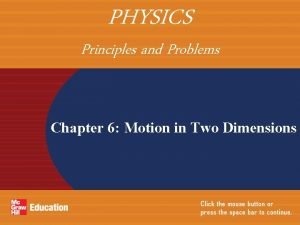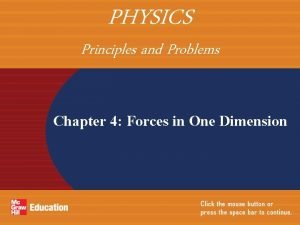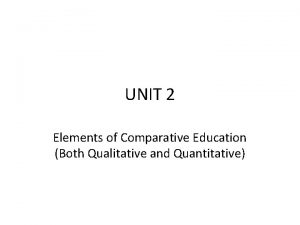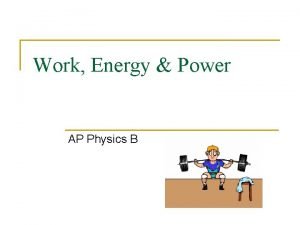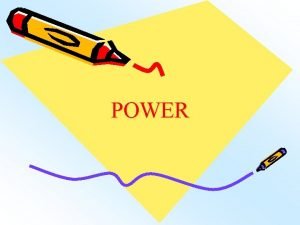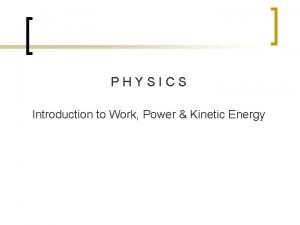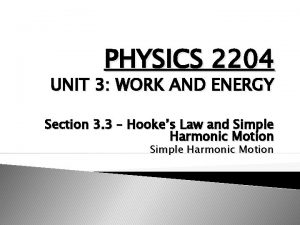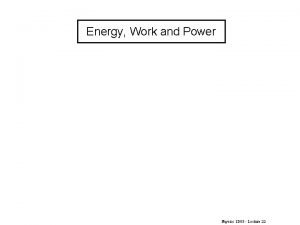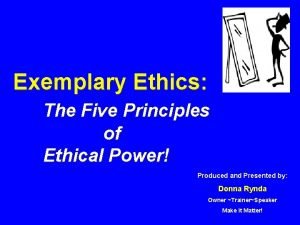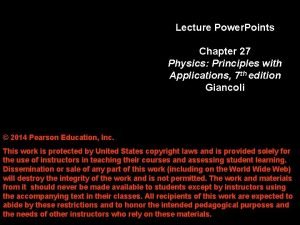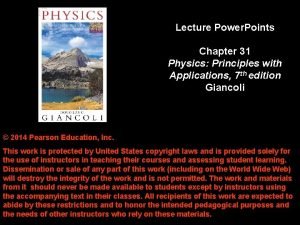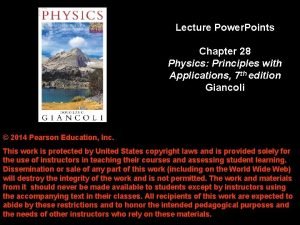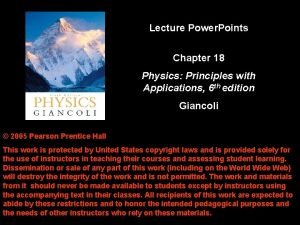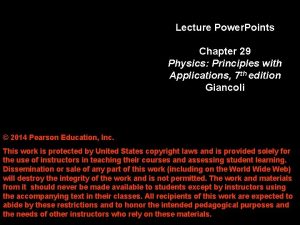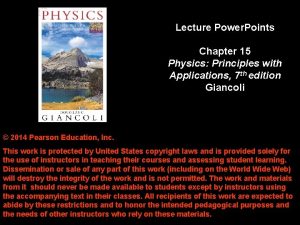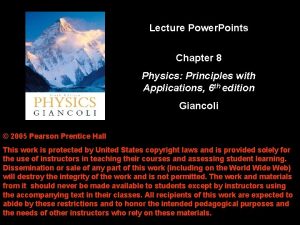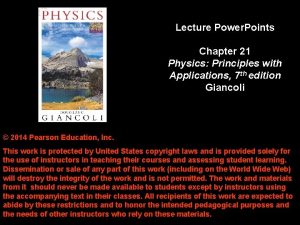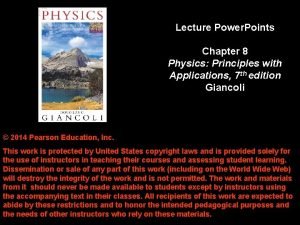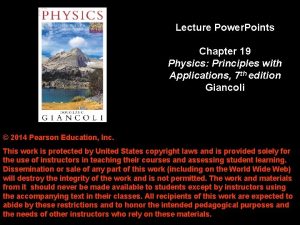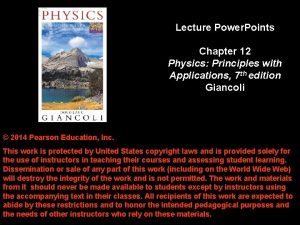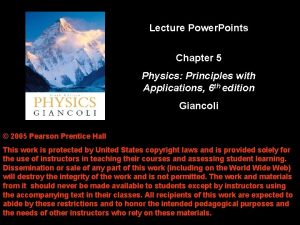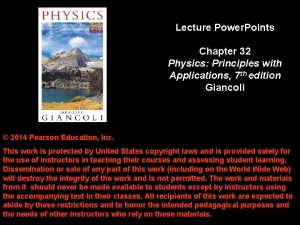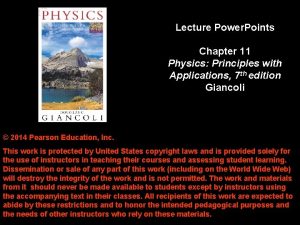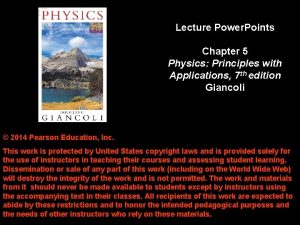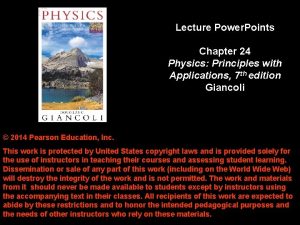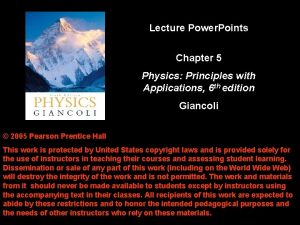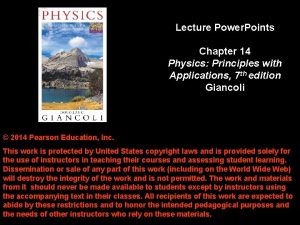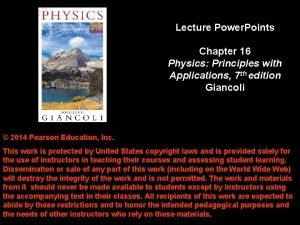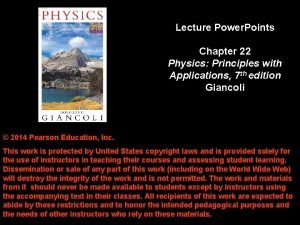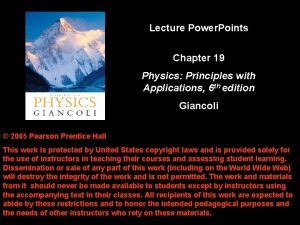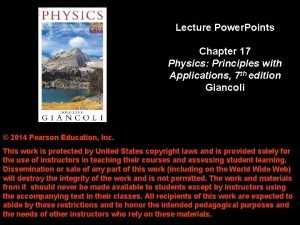Lecture Power Points Chapter 15 Physics Principles with














































- Slides: 46

Lecture Power. Points Chapter 15 Physics: Principles with Applications, 6 th edition Giancoli © 2005 Pearson Prentice Hall This work is protected by United States copyright laws and is provided solely for the use of instructors in teaching their courses and assessing student learning. Dissemination or sale of any part of this work (including on the World Wide Web) will destroy the integrity of the work and is not permitted. The work and materials from it should never be made available to students except by instructors using the accompanying text in their classes. All recipients of this work are expected to abide by these restrictions and to honor the intended pedagogical purposes and the needs of other instructors who rely on these materials.

Chapter 15 The Laws of Thermodynamics

15 -1 The First Law of Thermodynamics The change in internal energy of a closed system will be equal to the heat added to the system minus the work done by the system on its surroundings. (15 -1) (Δ U = Q + W on formula sheet) This is the law of conservation of energy, written in a form useful to systems involving heat transfer.

15 -1 The First Law of Thermodynamics • If work is done on the system, W is negative and the internal energy increases. • If Heat leaves the system, Q is negative and the internal energy decreases. • If the system is isolated, ΔU = 0.

15 -1 The First Law of Thermodynamics An amount of heat equal to 2500 J is added to a system, and 1800 J of work is done on the system. What is the change in internal energy of the system? Q = +2500 J W = -1800 J Δ U = Q – W = +2500 – (-1800) = 4300 J

15 -1 The First Law of Thermodynamics What would be the internal energy change if 2500 J of heat is added to the system and 1800 J of work is done by the system (i. e. as output)? Q = +2500 J W = +1800 J Δ U = Q – W = +2500 – (+1800) = 700 J

A 3. 0 g bullet traveling at a speed of 400. m/s enters a tree and exits the other side with a speed of 200. m/s. Where did the bullet’s lost KE go, and how much energy was transferred?

15 -2 Thermodynamic Processes and the First Law An isothermal process is one where the temperature does not change.

15 -2 Thermodynamic Processes and the First Law Isothermal process • PV = n. RT , so PV = constant • If T = constant then ΔU = 0 (since U = 3/2 n. RT) • ΔU = Q – W becomes Q = W • The heat added to the gas = The work done by the gas.

15 -2 Thermodynamic Processes and the First Law In order for an isothermal process to take place, we assume the system is in contact with a heat reservoir – a body whose mass is so large that its temperature does not change significantly when heat is exchanged with our system. In general, we assume that the system remains in equilibrium throughout all processes.

PV diagram for an ideal gas undergoing isothermal processes at two different temperatures. If the temperature is to remain constant ( A → B), the gas must expand do an amount of work on the environment (the piston).

15 -2 Thermodynamic Processes and the First Law An adiabatic process is one where there is no heat flow into or out of the system (A → C).

15 -2 Thermodynamic Processes and the First Law Adiabatic process • Q = 0 so ΔU = - W • The internal energy decreases if system does work, such as when the gas expands the piston in a cylinder. • An adiabatic process can happen if the system is well-insulated or if the process happens very quickly.

PV diagram for adiabatic (AC) and isothermal (AB) processes on an ideal gas. If the internal energy decreases, the temperature decreases. Point C is at a lower temperature than point A. The process from Point A to Point C is called adiabatic expansion.

Work is done on the piston when the gas expands, moving the piston a distance d.

The process from Point C to Point A is called adiabatic compression. Work is done on the system, the internal energy increases, and the temperature increases.

15 -2 Thermodynamic Processes and the First Law An isobaric process (a) occurs at constant pressure; an isovolumetric (or isochoric) one (b) at constant volume.

15 -2 Thermodynamic Processes and the First Law If the pressure is constant, W = Fd and F = PA so the work done is the pressure multiplied by the change in volume ( W = PAd ) (W = - P ΔV on formula sheet) In an isovolumetric process, the volume does not change, so the work done is zero.

15 -2 Thermodynamic Processes and the First Law For processes where the pressure varies, the work done is the area under the P-V curve. For an isothermal process, estimate the area or use calculus.

In which process was more work done by the gas?

An ideal gas is slowly compressed at a constant pressure of 2. 0 atm from 10. 0 L to 2. 0 L as shown below from B to D. In this process, some heat flows out of the gas and the temperature goes _____. Heat is then added to the gas, holding the volume constant, and the pressure and temperature allowed to rise (line DA) until the temperature reaches its initial value. Calculate the total work done by the gas in the process BDA and the total heat flow into the gas.

In an engine, 0. 25 moles of an ideal monatomic gas in the cylinder expands rapidly and adiabatically against the piston. In the process, the temperature of the gas drops from 1150 K to 400 K. How much work does the gas do?

Determine the change in internal energy of 1. 00 L of water at 100. °C when it is fully boiled from liquid to gas, which results in 1671 L of steam at 100. °C. (Assume atmospheric pressure)

15 -4 The Second Law of Thermodynamics – Introduction The process above does not violate the first law of thermodynamics and the law of conservation of energy. Since this process does not occur in nature, the second law of thermodynamics was formulated.

15 -4 The Second Law of Thermodynamics – Introduction The second law of thermodynamics is a statement about which processes occur and which do not. There are many ways to state the second law; here is one: Heat can flow spontaneously from a hot object to a cold object; it will not flow spontaneously from a cold object to a hot object.

15 -5 Heat Engines It is easy to produce thermal energy using work, but how does one produce work using thermal energy? This is a heat engine; mechanical energy can be obtained from thermal energy only when heat can flow from a higher temperature to a lower temperature.

15 -5 Heat Engines We will discuss only engines that run in a repeating cycle; the change in internal energy over a cycle is zero, as the system returns to its initial state. The high temperature reservoir transfers an amount of heat QH to the engine, where part of it is transformed into work W and the rest, QL, is exhausted to the lower temperature reservoir. Note that all three of these quantities are positive.

15 -5 Heat Engines A steam engine is one type of heat engine.

15 -5 Heat Engines The internal combustion engine is a type of heat engine as well.

15 -5 Heat Engines Why does a heat engine need a temperature difference? Otherwise the work done on the system in one part of the cycle will be equal to the work done by the system in another part, and the net work will be zero.

15 -5 Heat Engines The efficiency of the heat engine is the ratio of the work done to the heat input (or QH ): (on formula sheet) Using conservation of energy to eliminate W, we find: (15 -4 a) (15 -4 b)

15 -5 Heat Engines The Carnot (ideal) engine was created to examine the efficiency of a heat engine. It is idealized, as it has no friction. Each leg of its cycle is reversible. The Carnot cycle consists of: • Isothermal expansion • Adiabatic expansion • Isothermal compression • Adiabatic compression An example is on the next slide.

15 -5 Heat Engines

15 -5 Heat Engines For an ideal reversible engine, the Carnot (ideal) efficiency can be written in terms of the temperature: (first part on formula sheet) From this we see that 100% efficiency can be achieved only if the cold reservoir is at absolute zero, which is impossible. Real engines have some frictional losses; the best achieve 60 -80% of the Carnot value of efficiency.

15 -6 Refrigerators, Air Conditioners, and Heat Pumps These appliances can be thought of as heat engines operating in reverse. By doing work, heat is extracted from the cold reservoir and exhausted to the hot reservoir.

15 -6 Refrigerators, Air Conditioners, and Heat Pumps

15 -6 Refrigerators, Air Conditioners, and Heat Pumps Refrigerator performance is measured by the coefficient of performance (COP): (15 -6 a) Substituting: (15 -6 b) (15 -6 c)

15 -6 Refrigerators, Air Conditioners, and Heat Pumps A heat pump can heat a house in the winter: (15 -7)

15 -7 Entropy and the Second Law of Thermodynamics Definition of the change in entropy S when an amount of heat Q is added: (15 -8) Another statement of the second law of thermodynamics: The total entropy of an isolated system never decreases.

15 -8 Order to Disorder Entropy is a measure of the disorder of a system. This gives us yet another statement of the second law: Natural processes tend to move toward a state of greater disorder. Example: If you put milk and sugar in your coffee and stir it, you wind up with coffee that is uniformly milky and sweet. No amount of stirring will get the milk and sugar to come back out of solution.

15 -8 Order to Disorder Another example: when a tornado hits a building, there is major damage. You never see a tornado approach a pile of rubble and leave a building behind when it passes. Thermal equilibrium is a similar process – the uniform final state has more disorder than the separate temperatures in the initial state.

15 -9 Unavailability of Energy; Heat Death Another consequence of the second law: In any natural process, some energy becomes unavailable to do useful work. If we look at the universe as a whole, it seems inevitable that, as more and more energy is converted to unavailable forms, the ability to do work anywhere will gradually vanish. This is called the heat death of the universe.

15 -12 Thermal Pollution and Global Warming The generation of electricity using solar energy (a) does not involve a heat engine, but fossil-fuel plants (b) and nuclear plants (c) do.

Passive solar energy system

15 -12 Thermal Pollution and Global Warming The heat output of any heat engine, QL, is referred to as thermal pollution, as it must be absorbed by the environment.

15 -12 Thermal Pollution and Global Warming Air pollution is also emitted by power plants, industries, and consumers. Some of this pollution results in a buildup of CO 2 in the atmosphere, contributing to global warming. This can be minimized through careful choices of fuels and processes. The thermal pollution, however, is a consequence of the second law, and is unavoidable; it can be reduced only by reducing the amount of energy we use.
 01:640:244 lecture notes - lecture 15: plat, idah, farad
01:640:244 lecture notes - lecture 15: plat, idah, farad Real power and reactive power
Real power and reactive power Bullseye brand positioning
Bullseye brand positioning Point of difference and point of parity
Point of difference and point of parity Physics 111 lecture notes
Physics 111 lecture notes Physics 101 lecture
Physics 101 lecture Physics 101 lecture 1
Physics 101 lecture 1 Physics 101 lecture notes pdf
Physics 101 lecture notes pdf Waves 2 physics notes
Waves 2 physics notes Atmospheric physics lecture notes
Atmospheric physics lecture notes Chapter 6 study guide motion in two dimensions
Chapter 6 study guide motion in two dimensions Chapter 4 assessment physics answers
Chapter 4 assessment physics answers Representing motion physics
Representing motion physics Principles of economics powerpoint lecture slides
Principles of economics powerpoint lecture slides Elements of comparative education
Elements of comparative education Power system dynamics and stability lecture notes
Power system dynamics and stability lecture notes Power system analysis lecture notes
Power system analysis lecture notes Power semiconductor devices lecture notes
Power semiconductor devices lecture notes Switch mode power supply lecture notes
Switch mode power supply lecture notes Power system dynamics and stability lecture notes
Power system dynamics and stability lecture notes Coso 2013 cube
Coso 2013 cube Prayer of authority
Prayer of authority Why does it happen
Why does it happen University physics with modern physics fifteenth edition
University physics with modern physics fifteenth edition Physics ia example
Physics ia example A 70 kg base runner
A 70 kg base runner Regents physics work power energy
Regents physics work power energy Watt definition
Watt definition Power vs work
Power vs work Define of work done
Define of work done Regents physics work power energy
Regents physics work power energy Physics 2204 unit 3: work, power, energy
Physics 2204 unit 3: work, power, energy Power equation physics
Power equation physics Human resource management 15th edition
Human resource management 15th edition Human resource management lecture chapter 1
Human resource management lecture chapter 1 Human resource management lecture chapter 1
Human resource management lecture chapter 1 Principles of ethical power for organization
Principles of ethical power for organization Solar power satellites and microwave power transmission
Solar power satellites and microwave power transmission Potential power
Potential power Flex28024a
Flex28024a What is dispersive power of plane transmission grating?
What is dispersive power of plane transmission grating? Power of a power property
Power of a power property General power rule
General power rule Power angle curve in power system stability
Power angle curve in power system stability Power bi training powerpoint
Power bi training powerpoint Power absorbed or supplied
Power absorbed or supplied To kill a mockingbird chapters
To kill a mockingbird chapters










